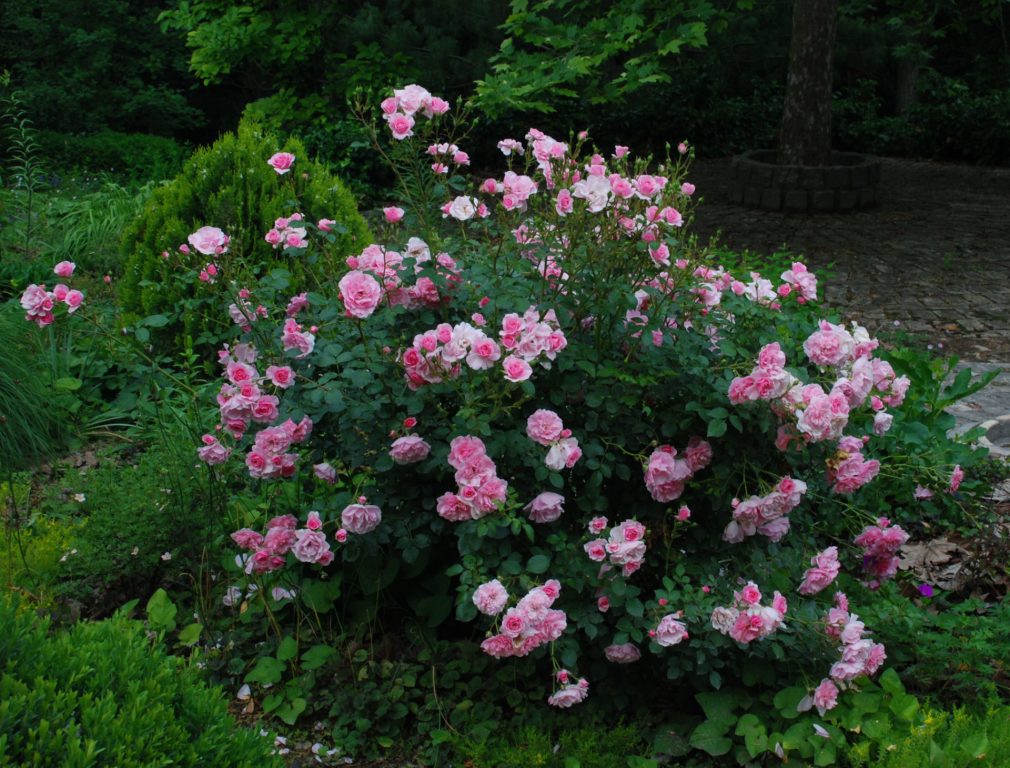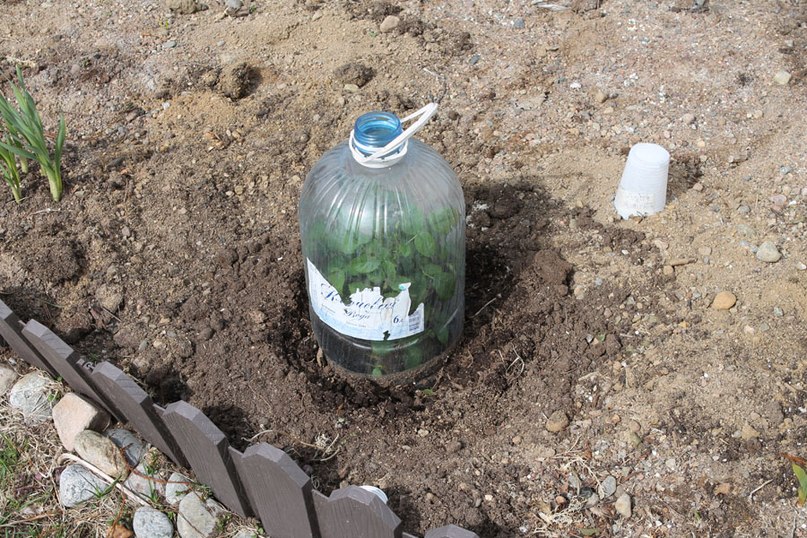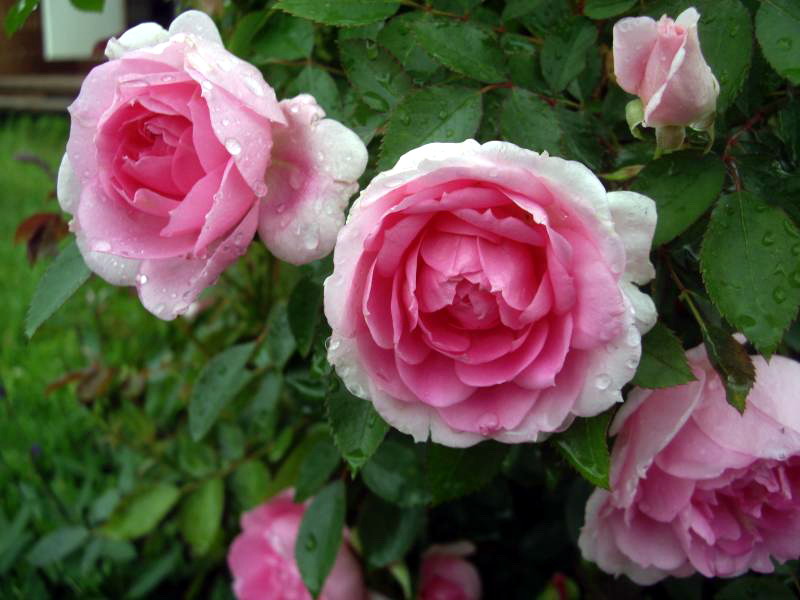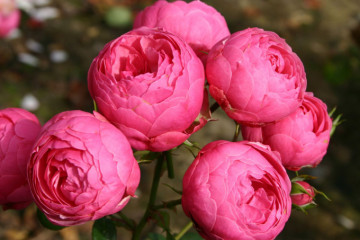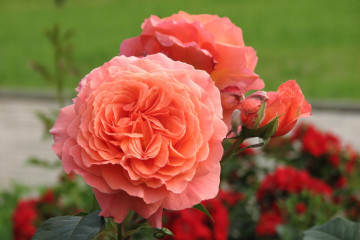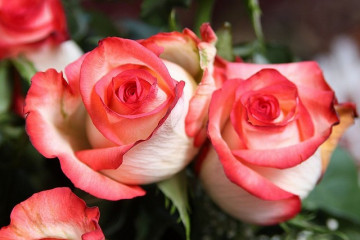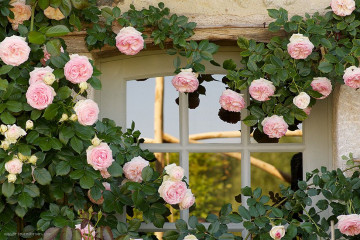Rose Prairie Joy - characteristics and description of the bush
Content:
Rose Prairie Joy belongs to the group of Canadian roses, has increased resistance to temperature extremes. Well suited for hedging, creates a spectacular accent in single or group mono planting.
Description of the variety
The originator of the variety, breeder Henry Marshall (Canada), introduced the variety in 1977. Twenty years later, Prairi Joy rose worldwide. In 1999, at a rose competition in Canada, the variety was awarded an award and the title of the best rose scrub of the year.
The declared dimensions of the plant are 1-1.5 m in height and 1.5 m in width. The bush is powerful, densely leafy. Shoots are arcuate, with few thorns.
Blooms profusely from late June until frost. Flowers of medium size (6-8 cm), collected in clusters of 10-15 pieces. Adult plants form clusters of up to 30 buds or more. The flower is densely double, pearlescent pink, with a darker center. Has a light apple flavor.
Flowers are slightly damaged by rain. Prairie Joy is a self-cleaning variety; wilted petals fall off on their own.
Landing rules
The rose grows well in elevated, protected from through winds, illuminated areas. In temperate and warm climates, it easily tolerates partial shade from trees and buildings.
Prairie Joy loves fertile soil with a high humus content, so the planting pit needs to be filled with a nutritious substrate.
It is recommended to add in equal parts:
- compost;
- peat;
- humus;
- sod land;
Additionally:
- 1 glass of ash;
- 1 cup blood or bone meal.
The recommended size of the planting pit is 60-70 cm deep, with a diameter of about half a meter. It is recommended to lay out the bottom of the pit in sandy soils with clay so that water and nutrients are retained at the roots. In heavy loam, sand is added before planting roses to increase the permeability of the soil.
Care features
Prairie Joy is an absolutely undemanding rose, it takes root quickly, blooms almost continuously and profusely. Relatively drought-resistant.
- Watering
In the dry season, at consistently high temperatures, it will still have to be watered. A large bush must be watered every 7 to 10 days. Roots need at least 12 - 15 liters of water.
Water the rose early in the morning or after the heat has subsided. It is advisable to use rainwater, settled or heated well water. It is recommended to mulch the near-trunk soil with a layer of dry grass. This will help not only retain moisture in the soil, but also get rid of weeds.
- Pruning
For a group of park roses, to which the Prairi Joy variety belongs, minimal pruning is required. In large 4-5 year old shrubs with spreading shoots, it is enough to cut off the tops to keep the plant within the allotted frames and stimulate the lateral buds to bloom.
It is imperative to cut off faded buds. The plant sheds petals on its own, but the fruit left on the peduncle slows down the appearance of new buds.
In the spring, before the start of sap flow, the main pruning, sanitary, is carried out. The awakened plant is cleaned of dry, broken, darkened branches.You need to carefully examine the shoots in order to eliminate the branches affected by an infectious burn. If the plant was in a shelter, traces of damping off are possible. The shoot is cut to a living tissue, it has a white color, with a green edging of healthy bark.
The cut is made at a slope towards the center of the bush, 1.5-2 cm above a healthy bud growing from the center. This method allows you to preserve the spreading shape of the plant, prevents the thickening of the rose bush.
To do this, cut shoots older than 3 years. They are thicker than others in diameter, have a coarse dark bark, and can lignify. Such branches are not able to bloom profusely, consume nutrients and greatly complicate the care of the rose. They should be cut without pity, up to the root collar.
- Top dressing
The abundantly blooming Prairie Joy rose consumes a large amount of nutrients during the season. If you do not take care of timely feeding, the plant will slow down in growth and reduce the intensity of flowering. There is a good chance that a weakened rose will not winter well.
Until mid-summer, the bush can be fed with nitrogenous fertilizers, they contribute to the active growth of greenery. Mineral fertilizers are used throughout the growing season. Before wintering, the plant should be fed with potassium-phosphorus fertilizer.
- Preparing for winter
The variety is extremely resistant to frost and sudden changes in temperature during thaws. It should be noted that it is still recommended to cover young bushes for the winter. The easier the plant overwinters, the faster it will start growing in spring and start flowering.
Breeding varieties
For gardeners in the northern regions, Canadian roses are the most reliable. Well-proven plants can be propagated by having a 4-5 year old healthy bush on the site.
Cuttings
For a Prairie Joy hedge, one-year-old cuttings are best suited. An adult formed rose, before the summer pruning, it is advisable to keep on a "diet" of organic matter. As practice has shown, feeding the mother bush with complex chemical fertilizers reduces the survival rate of the planting material.
- For cuttings, the faded July shoots are cut off. Their length is not less than 20 - 23 cm.
- Two five-leaf leaves are left on the resulting cuttings, large leaves can be shortened in half.
- Experienced gardeners recommend planting cuttings immediately in a permanent place so as not to disturb the plant with a transplant during the period of growing the root system.
- In order for the stalk to root with maximum comfort, greenhouse conditions are created for it. It is best to use the top of a blue plastic bottle (5-6 L). The presence of a cover will allow airing and hardening of the rooted plant.
- On hot sunny days, you can put some hay on the plastic "greenhouse" for shading.
Layers
This method is simple and effective. Allows you to get independent plants by the next season. The procedure is carried out in the spring, before bud break.
- The one-year-old shoot is carefully bent to the ground, if necessary, they do it in several steps.
- To fix it horizontally, it is pinned down with wooden, plastic or metal staples and sprinkled with earth.
- The top (10-15 cm) is fixed vertically, tying it to a peg.
You can speed up the process of growing roots by making a shallow oblique incision on the bottom of the pinned shoot, at the bend.
Diseases, pests and methods of control
The Prairie Joy Canadian rose has a high degree of resistance to black spot and powdery mildew. Typical pests also rarely appear on the plant.
For the prevention of possible diseases, it is recommended to adhere to the rules of agricultural technology:
- timely pruning: thickening of the bush contributes to the development of fungal infections;
- regular watering: during dry periods, the plant can be damaged by spider mites;
- systematic fertilization: helps to strengthen the plant's immunity.
Rose Prairie Joy, thanks to her docile nature and hardworking flowering throughout the season, is a welcome inhabitant of gardens and summer cottages. Delicate aroma and iridescent flowering will delight not only beginners, but also experienced gardeners.
